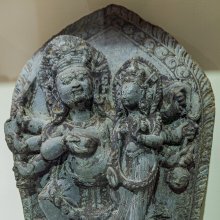Vyakhyana, Vyākhyāna: 20 definitions
Introduction:
Vyakhyana means something in Buddhism, Pali, Hinduism, Sanskrit, Marathi, Hindi. If you want to know the exact meaning, history, etymology or English translation of this term then check out the descriptions on this page. Add your comment or reference to a book if you want to contribute to this summary article.
Alternative spellings of this word include Vyakhyan.
Images (photo gallery)
(+3 more images available)
In Hinduism
Arthashastra (politics and welfare)
Source: Wisdom Library: ArthaśāstraVyākhyāna (व्याख्यान) refers to “explanation” and is the name of a yukti, or ‘technical division’, according to which the contents of the Arthaśāstra by Cāṇakya are grouped. Cāṇakya (4th-century BCE), aka Kauṭilya, was the chief minister of Chandragupta Maurya, the founder of the famous Maurya Empire.

Arthashastra (अर्थशास्त्र, arthaśāstra) literature concerns itself with the teachings (shastra) of economic prosperity (artha) statecraft, politics and military tactics. The term arthashastra refers to both the name of these scientific teachings, as well as the name of a Sanskrit work included in such literature. This book was written (3rd century BCE) by by Kautilya, who flourished in the 4th century BCE.
Vyakarana (Sanskrit grammar)
Source: Wikisource: A dictionary of Sanskrit grammar1) Vyākhyāna (व्याख्यान).—Explanation of a rule, or a line, or a verse by analysing the rule and giving examples and counter-examples; cf. न केवलानि चर्चापदानि व्याख्यानं वृद्धिः आत् ऎजिति । किं तर्हि । उदाहरणं प्रत्युदाहरणं वाक्याध्याहारः इत्ये-तत्समुदितं व्याख्यानं भवति । (na kevalāni carcāpadāni vyākhyānaṃ vṛddhiḥ āt ऎjiti | kiṃ tarhi | udāharaṇaṃ pratyudāharaṇaṃ vākyādhyāhāraḥ itye-tatsamuditaṃ vyākhyānaṃ bhavati |) M.Bh. Ahnika l Vart.11 ;
2) Vyākhyāna.—Authoritative decision given in places of doubt by ancient scholars; cf. व्याख्थानतो विशेषप्रतिपत्तिः न हि संदेहादलक्षणम् (vyākhthānato viśeṣapratipattiḥ na hi saṃdehādalakṣaṇam) M. Bh. Ahnika .1; Par.Sek.Pari.1.

Vyakarana (व्याकरण, vyākaraṇa) refers to Sanskrit grammar and represents one of the six additional sciences (vedanga) to be studied along with the Vedas. Vyakarana concerns itself with the rules of Sanskrit grammar and linguistic analysis in order to establish the correct context of words and sentences.
Shilpashastra (iconography)
Source: Shodhganga: The significance of the mūla-beras (śilpa)Vyākhyāna (व्याख्यान) or Vyākhyānamudrā refers to “essence, exposition of truth” and represents one of the twenty-four gestures with a single hand, as defined according to texts dealing with śilpa (arts and crafs), known as śilpaśāstras.—Accordingly, pratimā-lakṣaṇa (body postures of the icons) is comprised of hand gestures (hasta, mudrā or kai-amaiti), stances/poses (āsanas) and inflexions of the body (bhaṅgas). There are thirty-two types of hands [viz., vyākhyāna-mudrā] classified into two major groups known as tolirkai (functional and expressive gestures) and elirkai (graceful posture of the hand).

Shilpashastra (शिल्पशास्त्र, śilpaśāstra) represents the ancient Indian science (shastra) of creative arts (shilpa) such as sculpture, iconography and painting. Closely related to Vastushastra (architecture), they often share the same literature.
Ayurveda (science of life)
Source: gurumukhi.ru: Ayurveda glossary of termsVyākhyāna (व्याख्यान):—[vyākhyānam] Explanation; statements which elaborate a subject matter in detailed

Āyurveda (आयुर्वेद, ayurveda) is a branch of Indian science dealing with medicine, herbalism, taxology, anatomy, surgery, alchemy and related topics. Traditional practice of Āyurveda in ancient India dates back to at least the first millenium BC. Literature is commonly written in Sanskrit using various poetic metres.
Vastushastra (architecture)
Source: Brill: Śaivism and the Tantric Traditions (architecture)Vyākhyāna (व्याख्यान) refers to the “exposition (of the śāstras)”, according to the Mayasaṃgraha (verse 5.156-187).—Accordingly, [while describing the pura on a 9-by-9-plan and the 32 padas]—“At Gṛhakṣata one should set up [a storeroom for] bows, arrows, swords, and other weapons. At Yama there should be a place for ascetics to achieve contemplation of the self. Singers are stationed at Gandharva. At Bhṛṅga is a hall for the exposition [of the śāstras] [i.e., vyākhyāna-saṃśraya]. Or one may construct a large maṭha on the four [positions] which are Gṛhakṣata and [Yama, Gandharva and Bhṛṅga]”.

Vastushastra (वास्तुशास्त्र, vāstuśāstra) refers to the ancient Indian science (shastra) of architecture (vastu), dealing with topics such architecture, sculpture, town-building, fort building and various other constructions. Vastu also deals with the philosophy of the architectural relation with the cosmic universe.
Shaktism (Shakta philosophy)
Source: Google Books: ManthanabhairavatantramVyākhyāna (व्याख्यान) refers to the “explanation” (of the teaching of the lineage of the family of Siddhas), according to the Kularatnoddyota, one of the earliest Kubjikā Tantras.—Accordingly: “[...] Once the benefactor of the universe, Śrīnātha, called the primordial one, had spoken thus, he gave the Command to the goddess to bring the Śrīkula down (to earth) and explain (vyākhyāna) (the teaching of the) lineage of the family of Siddhas belonging to the Śrīkula. O beloved, you should explain this venerable teaching to one who has devotion. Then once the great lord had given that Command to the goddess and awakened (her), he took rest, O mistress of the gods, and remained silent. [...]

Shakta (शाक्त, śākta) or Shaktism (śāktism) represents a tradition of Hinduism where the Goddess (Devi) is revered and worshipped. Shakta literature includes a range of scriptures, including various Agamas and Tantras, although its roots may be traced back to the Vedas.
General definition (in Hinduism)
Source: archive.org: Vedic index of Names and SubjectsVyākhyāna (व्याख्यान) in one passage of the Śatapatha Brāhmaṇa clearly denotes a ‘narrative’ merely—viz., that of the dispute of Kadrū and Suparṇī. In other passages the word means simply ‘commentary’. In the Bṛhadāraṇyaka Upaniṣad, used in the plural, it signifies a species of writing, apparently ‘commentaries’, though its exact relation to Anuvyākhyāna must remain obscure. Sieg thinks that the Vyākhyānas were forms of narrative like Anvākhyāna and Anuvyākhyāna.
In Buddhism
Buddhist philosophy
Source: Google Books: A History of Indian Logic (Buddhist Philosophy)Vyākhyāna (व्याख्यान) refers to an “explanation”, according to Upāyakauśalyahṛdaya, an ancient work on the art of debate composed by Bodhisattva Nāgārjuna.—In Chinese this work is called Fan-pien-sin-lun. It was translated into Chinese by Ci-cia-ye and Than-yao in A.D. 472.—Seeing that the Vaiśeṣika and other systems were obscure in their terminology, Nāgārjuna, it is reported, undertook to write this book to give a clear exposition of the art of debate. The book is divided into four chapters styled respectively as (I) an elucidation of debate (vāda-visadīkaraṇa), (II) an explanation of the points of defeat (nigrahasthāna), (III) an explanation of the truths (tattva-vyākhyāna), and (IV) the analogue or far-fetched analogy (jāti).
Note: Tattva-vyākhyāna (“an explanation of the truths”) deals mainly with the admission of an opinion (matānujñā)
-
Languages of India and abroad
Marathi-English dictionary
Source: DDSA: The Molesworth Marathi and English Dictionaryvyākhyāna (व्याख्यान).—n S Expounding or interpreting; making gloss or comment upon. 2 Unfolding and explaining in general.
Source: DDSA: The Aryabhusan school dictionary, Marathi-Englishvyākhyāna (व्याख्यान).—n Making comment upon A lecture. Expound
Marathi is an Indo-European language having over 70 million native speakers people in (predominantly) Maharashtra India. Marathi, like many other Indo-Aryan languages, evolved from early forms of Prakrit, which itself is a subset of Sanskrit, one of the most ancient languages of the world.
Sanskrit dictionary
Source: DDSA: The practical Sanskrit-English dictionaryVyākhyāna (व्याख्यान).—
1) Communication, narration.
2) Speech, lecture.
3) Explanation, exposition, interpretation, comment.
Derivable forms: vyākhyānam (व्याख्यानम्).
Source: Cologne Digital Sanskrit Dictionaries: Shabda-Sagara Sanskrit-English DictionaryVyākhyāna (व्याख्यान).—n.
(-naṃ) 1. Narration, speech. 2. Explanation, interpretation, exposition. E. vi and āṅ before khyā to say, lyuṭ aff.
Source: Cologne Digital Sanskrit Dictionaries: Benfey Sanskrit-English DictionaryVyākhyāna (व्याख्यान).—i. e. vi-ā-khyā + ana, n. Explaining.
Source: Cologne Digital Sanskrit Dictionaries: Cappeller Sanskrit-English DictionaryVyākhyāna (व्याख्यान).—[feminine] ī explaining, reminding of ([genetive]) [neuter] explanation, recitation, story, tale.
Source: Cologne Digital Sanskrit Dictionaries: Monier-Williams Sanskrit-English Dictionary1) Vyākhyāna (व्याख्यान):—[=vy-ākhyāna] [from vyā-khyā] mf(ī)n. explaining, expounding commenting, [Pāṇini 4-3, 66 [Scholiast or Commentator]]
2) [v.s. ...] (with [genitive case]) reminding of. id est. resembling, [Pāṇini; ib.], Vārtt.4, [Patañjali]
3) [v.s. ...] n. explaining, exposition, interpretation, gloss, comment, [Śatapatha-brāhmaṇa] etc. etc.
4) [v.s. ...] narration, [Śatapatha-brāhmaṇa]
5) [v.s. ...] recitation, [ib.]
Source: Cologne Digital Sanskrit Dictionaries: Yates Sanskrit-English DictionaryVyākhyāna (व्याख्यान):—[vyā-khyāna] (naṃ) 1. n. Explaining.
Source: DDSA: Paia-sadda-mahannavo; a comprehensive Prakrit Hindi dictionary (S)Vyākhyāna (व्याख्यान) in the Sanskrit language is related to the Prakrit word: Vakkhāṇa.
[Sanskrit to German]
Sanskrit, also spelled संस्कृतम् (saṃskṛtam), is an ancient language of India commonly seen as the grandmother of the Indo-European language family (even English!). Closely allied with Prakrit and Pali, Sanskrit is more exhaustive in both grammar and terms and has the most extensive collection of literature in the world, greatly surpassing its sister-languages Greek and Latin.
Hindi dictionary
Source: DDSA: A practical Hindi-English dictionaryVyākhyāna (व्याख्यान) [Also spelled vyakhyan]:—(nm) speech, lecture, oration; exposition, interpretation, elaboration; ~[dātā] an orator; a lecturer; —[viṣayaka/saṃbaṃdhī] oratorical; —[jhāḍanā] (said in a satirical vein) to deliver a discourse (to an unwilling listener), to dump a discourse on.
...
Kannada-English dictionary
Source: Alar: Kannada-English corpusVyākhyāna (ವ್ಯಾಖ್ಯಾನ):—
1) [noun] a setting forth of facts, ideas, etc.; detailed explanation.
2) [noun] a series of explanatory notes or annotations for a difficult a text, aphorisms, concise statements, etc.; a commentary.
3) [noun] an informative talk given as before an audience or class and usu. prepared beforehand; a lecture.
4) [noun] ವ್ಯಾಖ್ಯಾನ ಬಿಗಿ [vyakhyana bigi] vyākhyāna bigi to give a lecture to; 2. (sarc.) to give advice to; ವ್ಯಾಖ್ಯಾನ ಮಾಡು [vyakhyana madu] vyākhyāna māḍu to make comments in detail on; to provide critical or explanatory notes or interpretations for (a literary work, etc.); to annotate.
Kannada is a Dravidian language (as opposed to the Indo-European language family) mainly spoken in the southwestern region of India.
See also (Relevant definitions)
Partial matches: Vy, Khyana, Vya, Akhyana.
Starts with: Vyakhyana-manca, Vyakhyanakara, Vyakhyanamala, Vyakhyanamgey, Vyakhyanamudra, Vyakhyananda, Vyakhyanapitha, Vyakhyanaprakriya, Vyakhyanaratnamala, Vyakhyanaratnavali, Vyakhyanasamshraya, Vyakhyanashala, Vyakhyanashale, Vyakhyanashiromani, Vyakhyanavedika, Vyakhyanavidhi, Vyakhyanavivarana, Vyakhyanay, Vyakhyanaya, Vyakhyanayogya.
Ends with (+41): Abdavishayavyakhyana, Abhinavavyakhyana, Anuvyakhyana, Apekshavyakhyana, Apekshitavyakhyana, Ashtakashaucavyakhyana, Atthavyakhyana, Avyakhyana, Bhagavatapadyatrayivyakhyana, Brahmasutranuvyakhyana, Brihajjatakashlokavyakhyana, Caturmasakatrayivyakhyana, Darshapurnamasamantravyakhyana, Darshapurnamasavyakhyana, Dharmapradipavyakhyana, Ekavyakhyana, Gajasutravyakhyana, Ganavyakhyana, Gaurivallabhashlokavyakhyana, Hiranyakeshisutravyakhyana.
Full-text (+97): Anuvyakhyana, Vakkhana, Vyakhyanashala, Vyakhyanaya, Vyakhyanamala, Vyakhyanavivarana, Vyakhyanayogya, Vyakhyanaprakriya, Vyakhyanaratnavali, Avyakhyana, Padavyakhyana, Vyakhyeya, Vyakhyayika, Vrittadipavyakhyana, Yogasutra, Vyakhyanisu, Vakhana, Upavarnana, Vakhananem, Vishnutirthiyavyakhyana.
Relevant text
Search found 42 books and stories containing Vyakhyana, Vyākhyāna, Vy-akhyana, Vy-ākhyāna, Vya-khyana, Vyā-khyāna; (plurals include: Vyakhyanas, Vyākhyānas, akhyanas, ākhyānas, khyanas, khyānas). You can also click to the full overview containing English textual excerpts. Below are direct links for the most relevant articles:
Garga Samhita (English) (by Danavir Goswami)
Verse 1.15.66 < [Chapter 15 - Revelation of the Universal Form to Nanda’s Wife]
Chandogya Upanishad (Madhva commentary) (by Srisa Chandra Vasu)
Formal Education System in Ancient India (by Sushmita Nath)
Subjects studied in the Brahmanic Period < [Chapter 5 - Subjects studied in the Vedic and Buddhist period]
Education in the Brahmanic Period < [Chapter 1 - Introduction]
Taittiriya Upanishad Bhashya Vartika (by R. Balasubramanian)
Verse 2.473 < [Book 2 - Brahmavallī]
Temples of Munnur (Historical Study) (by R. Muthuraman)
Images of Daksinamurti < [Chapter 5]
Lakulisha-Pashupata (Philosophy and Practice) (by Geetika Kaw Kher)
Vyakhyana Daksinamurti < [Chapter 3 - The Ritualistic Context]
Overall Structure and Methodological considerations < [Introduction]





